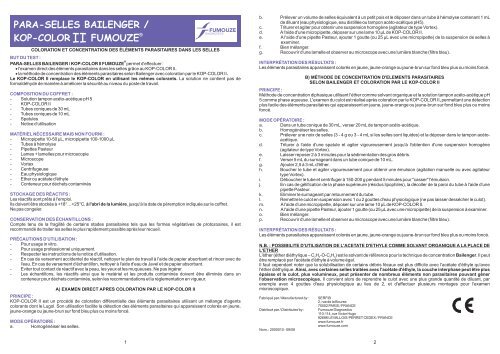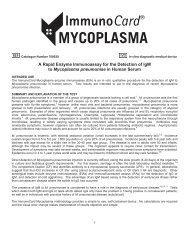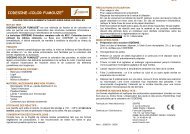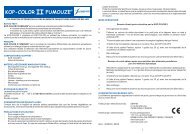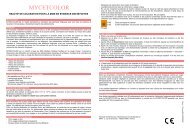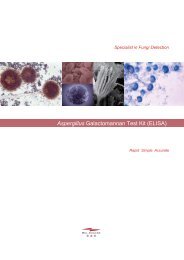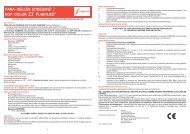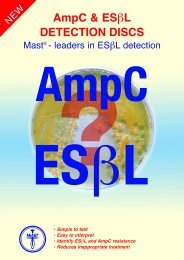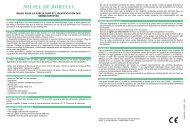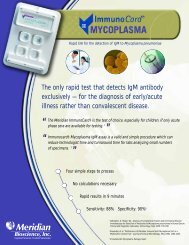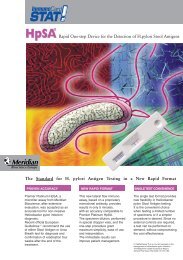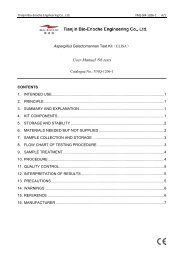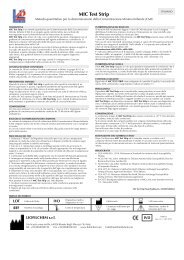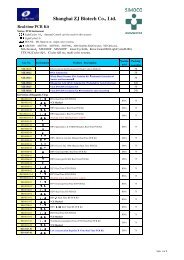para-selles bailenger - Simoco Diagnostics
para-selles bailenger - Simoco Diagnostics
para-selles bailenger - Simoco Diagnostics
- No tags were found...
You also want an ePaper? Increase the reach of your titles
YUMPU automatically turns print PDFs into web optimized ePapers that Google loves.
PARA-SELLES BAILENGER /®KOP-COLOR FUMOUZEIICOLORATION ET CONCENTRATION DES ÉLÉMENTS PARASITAIRES DANS LES SELLESb. Prélever un volume de <strong>selles</strong> équivalent à un petit pois et le déposer dans un tube à hémolyse contenant 1 mLde diluant (eau physiologique, eau distillée ou tampon acéto-acétique pH5).c. Triturer et agiter pour obtenir une suspension homogène (agitateur de type Vortex).d. A l'aide d'une micropipette, déposer sur une lame 10 µL de KOP-COLOR II.e. A l'aide d'une pipette Pasteur, ajouter 1 goutte (ou 25 µL avec une micropipette) de la suspension de <strong>selles</strong> àexaminer.f. Bien mélanger.g. Recouvrir d'une lamelle et observer au microscope avec une lumière blanche (filtre bleu).BUT DU TEST :®PARA-SELLES BAILENGER / KOP-COLOR II FUMOUZE permet d'effectuer :INTERPRÉTATION DES RÉSULTATS :l'examen direct des éléments <strong>para</strong>sitaires dans les <strong>selles</strong> grâce au KOP-COLOR II.Les éléments <strong>para</strong>sitaires ap<strong>para</strong>issent colorés en jaune, jaune-orange ou jaune-brun sur fond bleu plus ou moins foncé.la méthode de concentration des éléments <strong>para</strong>sitaires selon Bailenger avec coloration par le KOP-COLOR II.Le KOP-COLOR II remplace le KOP-COLOR en utilisant les mêmes colorants. La solution ne contient pas deB) MÉTHODE DE CONCENTRATION D'ELEMENTS PARASITAIRESformaldéhyde de manière à améliorer la sécurité au niveau du poste de travail.SELON BAILENGER ET COLORATION PAR LE KOP-COLOR IIPRINCIPE :COMPOSITION DU COFFRET :Méthode de concentration diphasique utilisant l'éther comme solvant organique et la solution tampon acéto-acétique pH- Solution tampon acéto-acétique pH 5 5 comme phase aqueuse. L'examen du culot est réalisé après coloration par le KOP-COLOR II, permettant une détection- KOP-COLOR II plus facile des éléments <strong>para</strong>sitaires qui ap<strong>para</strong>issent en jaune, jaune-orange ou jaune-brun sur fond bleu plus ou moins- Tubes coniques de 30 mL foncé.- Tubes coniques de 10 mL- SpatulesMODE OPÉRATOIRE :- Notice d'utilisation a. Dans un tube conique de 30 mL, verser 20 mL de tampon acéto-acétique.b. Homogénéiser les <strong>selles</strong>.MATÉRIEL NÉCESSAIRE MAIS NON FOURNI :c. Prélever une noix de <strong>selles</strong> (3 - 4 g ou 3 - 4 mL si les <strong>selles</strong> sont liquides) et la déposer dans le tampon acéto-- Micropipette 10-50 µL, micropipette 100-1000 µL acétique.- Tubes à hémolyse d. Triturer à l'aide d'une spatule et agiter vigoureusement jusqu'à l'obtention d'une suspension homogène- Pipettes Pasteur (agitateur de type Vortex).- Lames + lamelles pour microscopie e. Laisser reposer 2 à 3 minutes pour la sédimentation des gros débris.- Microscope f. Verser 5 mL du surnageant dans un tube conique de 10 mL.- Vortex g. Ajouter 2,5 à 3 mL d'éther.- Centrifugeuse h. Boucher le tube et agiter vigoureusement pour obtenir une émulsion (agitation manuelle ou avec agitateur- Eau physiologique type Vortex).- Ether ou acétate d'éthyle i. Déboucher le tube et centrifuger à 150-200 g pendant 5 minutes pour "casser" l'émulsion.- Conteneur pour déchets contaminés j. En cas de gélification de la phase supérieure (résidus lipophiles), la décoller de la paroi du tube à l'aide d'unepipette Pasteur.k. Eliminer le surnageant par retournement du tube.STOCKAGE DES RÉACTIFS :Les réactifs sont prêts à l'emploi. l. Remettre le culot en suspension avec 1 ou 2 gouttes d'eau physiologique (ne pas laisser dessécher le culot).Ils doivent être stockés à +18°…+25°C, à l'abri de la lumière, jusqu'à la date de péremption indiquée sur le coffret. m. A l'aide d'une micropipette, déposer sur une lame 10 µL de KOP-COLOR II.Ne pas congeler. n. A l'aide d'une pipette Pasteur, ajouter 1 goutte (ou 25 µL avec une micropipette) de la suspension à examiner.CONSERVATION DES ÉCHANTILLONS :Compte tenu de la fragilité de certains stades <strong>para</strong>sitaires tels que les formes végétatives de protozoaires, il estrecommandé de traiter les <strong>selles</strong> le plus rapidement possible après leur recueil.o. Bien mélanger.p. Recouvrir d'une lamelle et observer au microscope avec une lumière blanche (filtre bleu).INTERPRÉTATION DES RÉSULTATS :Les éléments <strong>para</strong>sitaires ap<strong>para</strong>issent colorés en jaune, jaune-orange ou jaune-brun sur fond bleu plus ou moins foncé.PRÉCAUTIONS D'UTILISATION :- Pour usage in vitro. N.B. : POSSIBILITE D'UTILISATION DE L'ACETATE D'ETHYLE COMME SOLVANT ORGANIQUE A LA PLACE DE- Pour usage professionnel uniquement. L'ETHER- Respecter les instructions de la notice d'utilisation. L'éther (éther diéthylique – C2H5-O-C2H 5) est le solvant de référence pour la technique de concentration Bailenger. Il peut- En cas de versement accidentel de réactif, nettoyer le plan de travail à l'aide de papier absorbant et rincer avec de être remplacé par l'acétate d'éthyle à volume égal.l'eau. En cas de versement d'échantillon, nettoyer à l'aide d'eau de Javel et de papier absorbant.Il faut cependant noter que la solubilisation de certains débris fécaux est plus difficile avec l'acétate d'éthyle qu'avec- Eviter tout contact de réactif avec la peau, les yeux et les muqueuses. Ne pas ingérer. l'éther diéthylique. Ainsi, avec certaines <strong>selles</strong> traitées avec l'acétate d'éthyle, la couche interphase peut être plus- Les échantillons, les réactifs ainsi que le matériel et les produits contaminés doivent être éliminés dans un épaisse et le culot, plus volumineux, peut présenter de nombreux éléments non <strong>para</strong>sitaires pouvant gênerconteneur pour déchets contaminés, selon les recommandations et la réglementation en vigueur.A) EXAMEN DIRECT APRES COLORATION PAR LE KOP-COLOR IIl'observation microscopique. Il convient alors de reprendre le culot avec une plus grande quantité de diluant, parexemple avec 4 gouttes d'eau physiologique au lieu de 2, et d'effectuer plusieurs montages pour l'examenmicroscopique.PRINCIPE :KOP-COLOR II est un procédé de coloration différentielle des éléments <strong>para</strong>sitaires utilisant un mélange d'agentscolorants dont le Lugol. Son utilisation facilite la détection des éléments <strong>para</strong>sitaires qui ap<strong>para</strong>issent colorés en jaune,jaune-orange ou jaune-brun sur fond bleu plus ou moins foncé.MODE OPÉRATOIRE :a. Homogénéiser les <strong>selles</strong>.Fabriqué par / Manufactured by :Distribué par / Distributed by :Nom. : 2000010 - 09/08SERFIB2, rue de la Bourse75002 PARIS / FRANCEFumouze <strong>Diagnostics</strong>110-114, rue Victor Hugo92686 LEVALLOIS-PERRET CEDEX / FRANCEwww.fumouze.frwww.fumouze.com1 2
PARA-SELLES BAILENGER /®KOP-COLOR FUMOUZEIIe. Using the Pasteur pipette, add 1 drop (or, using the micropipette, add 25 µL) of the stools suspension toexamine.f. Mix well.g. Place a coverglass over the stools suspension and examine by using a microscope having a white light (bluefilter).INTERPRETATION OF THE RESULTS:STAINING AND CONCENTRATION OF PARASITIC ELEMENTS IN STOOLSParasitic elements appear to be yellow, yellow-orange or brownish-yellow on a more or less dark blue background.INTENDED USE:B) CONCENTRATION OF PARASITIC ELEMENTS BASED ON® BAILENGER'S METHOD WITH KOP-COLOR II STAININGPARA-SELLES BAILENGER / KOP-COLOR II FUMOUZE allows performing:the direct examination of <strong>para</strong>sitic elements in stools with the KOP-COLOR II.the concentration of <strong>para</strong>sitic elements based on Bailenger's method with KOP-COLOR II staining.PRINCIPLE:Two phase method of concentration using ether as an organic solvent and a pH 5 aceto-acetate buffer solution as theKOP-COLOR II replaces KOP-COLOR while using the same staining agents. The solution contains no formalin so as aqueous phase. The examination of sediment is performed after staining by KOP-COLOR II which facilitates theto improve the work station safety.detection of <strong>para</strong>sitic elements which appear to be yellow, yellow-orange or brownish-yellow on a more or less dark blueKIT CONTENT:background.- pH 5 aceto-acetate buffer solutionTEST PROCEDURE:- KOP-COLOR IIa. Pour 20 mL of the aceto-acetate buffer in a 30 mL conical tube.- Conical tubes of 30 mLb. Homogenize stools.- Conical tubes of 10 mLc. Take out the equivalent of a knob of the stools (3 to 4 g or 3 to 4 mL if the stools are fluid) and place it in the- Spatulasaceto-acetate buffer.- Package insertd. Triturate the stools by using a spatula and shake the mixture vigorously until a homogeneous suspension isobtained (Vortex shaker).MATERIAL REQUIRED BUT NOT PROVIDED:e. Permit the mixture to settle for 2 or 3 minutes for the sedimentation of the coarser particles.- Micropipette 10-50 µL, micropipette 100-1000 µLf. Pour 5 mL of supernatant in a 10 mL conical tube.- Haemolysis tubesg. Add 2.5 to 3 mL of ether.- Pasteur pipettesh. Plug the tube and shake vigorously in order to obtain an emulsion (shake manually or with a Vortex shaker).- Slides + coverglasses for microscopyi. Take the plug out of the tube and centrifuge the mixture (150-200 g) for 5 minutes to "break" the emulsion.- Microscopej. In the case of gelling in the higher phase (due to lipophile residues), loosen the emulsion from the tube walls- Vortexusing the Pasteur pipette.- Centrifugek. Eliminate the supernatant by turning the tube upside down.- Physiological salinel. Put the sediment in a suspension using 1 or 2 drops of physiological saline (do not allow the sediment to dry- Ether or ethyl acetateup).- Container for contaminated wastesm. Using the micropipette, place 10 µL of KOP-COLOR II on a slide.STORAGE CONDITIONS:n. Using the Pasteur pipette, add 1 drop (or, using the micropipette, add 25 µL) of the suspension to examine.Reagents are ready-to-use.o. Mix well.Store at +18°…+25°C, sheltered from sunlight, until the expiry date indicated on the box. Do not freeze.p. Place a coverglass over the sediment suspension and examine under a microscope using a white light (blueSAMPLES STORAGE:filter).Due to the fragility of some of <strong>para</strong>sitic stages as protozoa vegetative forms, it is recommended to treat stools as soon aspossible after their collection.INTERPRETATION OF THE RESULTS:The <strong>para</strong>sitic elements appear to be yellow, yellow-orange or brownish-yellow on a more or less dark blue background.WARNINGS AND PRECAUTIONS:- For in vitro diagnostic use.- Only for professional use.- Follow the instructions for use.- In case of accidental spill of reagents, clean the surface with absorbent paper and water. In case of spill of sample,clean the surface with absorbent paper and bleach.- Avoid contact of reagent with skin, eyes and mucous membranes. Do not ingest.- The samples, reagents as well as contaminated materials and products must be eliminated in a container forcontaminated wastes, according to the prevailing recommendations and regulations.N.B.: POSSIBILITY OF USING ETHYL ACETATE AS ORGANIC SOLVENT INSTEAD OF ETHEREther (diethyl ether – C2H 5 – O – C2H 5) is the reference solvent for Bailenger concentration method. It can be replaced byethyl acetate in equal volume. It is however necessary to note that the solubilisation of certain faecal fragments is moredifficult with ethyl acetate than with diethyl ether. So, with some stools treated with ethyl acetate, the interface layermay be thicker and the more voluminous sediment may present numerous non-<strong>para</strong>sitic elements which mayhamper microscopic observation. It is then advisable to take back the sediment with more diluent, for example with 4drops of physiological water instead of 2, and to make several assemblies for the microscopic examination.A) DIRECT EXAMINATION AFTER STAINING BY KOP-COLOR IIBIBLIOGRAPHIE / REFERENCES :1. A. O'FEL - Parasitologie mycologie - Format Utile, Saint-Maur.PRINCIPLE:2. J. BAILENGER - Coprologie <strong>para</strong>sitaire et fonctionnelle - Imprimerie Drouillard, Bordeaux.KOP-COLOR II is a differential staining process of <strong>para</strong>sitic elements using a mixture of staining agents one of which is 3. P. BOURÉE - Aide mémoire de <strong>para</strong>sitologie - Flammarion, Paris.Lugol.4. A.-M. DELUOL - Atlas de <strong>para</strong>sitologie - Guide pratique du diagnostic au microscope - (tomes I, II, III). Edition Varia, Paris.Its utilization facilitates the detection of <strong>para</strong>sitic elements which appear to be yellow, yellow-orange or brownish-yellow 5. J.-P. NOZAIS, A. DATRY, M. DANIS, C. BOUDON - Traité de <strong>para</strong>sitologie médicale - Pradel, Paris.on a more or less dark blue background.6. M. GENTILLINI, B. DUFLO - Médecine tropicale de voyage - Flammarion Médecine Sciences, Paris.TEST PROCEDURE:7. Y.-J. GOLVAN - Eléments de <strong>para</strong>sitologie médicale - Flammarion, Paris.8. H. LEGER, M.-J. NOTTEGHEM - Guide de <strong>para</strong>sitologie pratique - SEDES, Paris.a. Homogenize stools. 9. C. JUNOD - Recherche spéciale des oeufs et larves d'Helminthes dans les <strong>selles</strong> par la méthode des concentrationsb. Take out a volume of stools equivalent to the size of a pea and place it in a haemolysis tube containing 1 mL ofcombinées - Feuillets de biologie, 92 : 55-62 (1976).thinner (physiological saline, distilled water or pH5 aceto-acetate buffer solution).10. D. ENGELS, S. NAHIMANA, B. GRYSEELS - Comparison of the direct faecal smear and two thick smear techniques for thec. Triturate and shake it to obtain a homogeneous suspension (Vortex shaker).diagnosis of intestinal <strong>para</strong>sitic infections - Transactions of the Royal Society of Tropical Medecine and Hygiene, 90 : 523-d. Using the micropipette, place 10 µL of KOP-COLOR II on a slide.525 (1996).3 4


